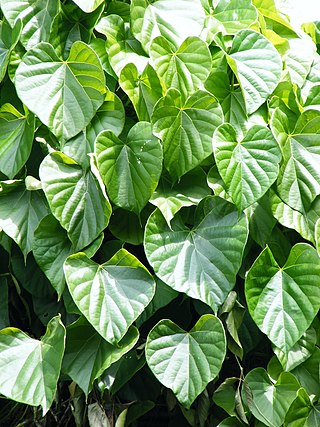
Dalbergia is a large genus of small to medium-size trees, shrubs and lianas in the pea family, Fabaceae, subfamily Faboideae. It was recently assigned to the informal monophyletic Dalbergia clade : the Dalbergieae. The genus has a wide distribution, native to the tropical regions of Central and South America, Africa, Madagascar and Southern Asia.

Cassia is a genus of flowering plants in the legume family, Fabaceae, and the subfamily Caesalpinioideae. Species are known commonly as cassias. The genus includes 37 species and has a pantropical distribution. Species of the genera Senna and Chamaecrista were previously included in Cassia. Cassia now generally includes the largest species of the legume subtribe Cassiinae, usually mid-sized to tall trees.

Chrysophyllum is a group of trees in the Sapotaceae described as a genus by Linnaeus in 1753.

Manilkara is a genus of trees in the family Sapotaceae. They are widespread in tropical and semitropical locations, in Africa, Madagascar, Asia, Australia, and Latin America, as well as various islands in the Pacific and in the Caribbean. A close relative is the genus Pouteria.

Cynometra is genus of tropical forest trees with a pantropical distribution.

The subfamily Detarioideae is one of the subdivisions of the plant family Fabaceae (legumes). This subfamily includes many tropical trees, some of which are used for timber or have ecological importance. The subfamily consists of 84 genera, most of which are native to Africa and Asia. Pride of Burma and tamarind are two of the most notable species in Detarioideae. It has the following clade-based definition:
The most inclusive crown clade containing Goniorrhachis marginataTaub. and Aphanocalyx cynometroidesOliv., but not Cercis canadensisL., Duparquetia orchidaceaBaill., or Bobgunnia fistuloides(Harms) J. H. Kirkbr. & Wiersema.

Dialium is a genus of flowering plants in the family Fabaceae, subfamily Dialioideae. Velvet tamarind is a common name for several species. The genus includes 37 species which range from the tropical Americas to sub-Saharan Africa, Madagascar, India, Indochina, and western Malesia.

Gilbertiodendron is a genus of legume in the family Fabaceae. It consists of about 25 species of tree native to west and west-central tropical Africa. Members of this genus were formerly considered to be in the genus Macrolobium but that genus is now restricted to species growing in tropical America. It is closely related to Pellegriniodendron.

Hymenostegia is a genus of flowering plants in the family Fabaceae. It includes 14 species native to west and west-central tropical Africa.

Anonidium is a genus of plants in family Annonaceae.

Tapura is a genus of plant in the family Dichapetalaceae.

Artabotrys is a genus of plants in the Annonaceae family. There are over 100 species in the Old World tropics, with 31 species in Africa. It is part of the custard apple family (Annonaceae). All species are small trees or shrubs with a tendency to climb. Leaves are simple and alternate, without hairs. Bisexual flowers are borne singly or in clusters opposite the leaves. The 6-petalled flowers are scented, and the plant bears fleshy fruits.

Englerophytum is a group of trees in the family Sapotaceae described as a genus in 1914.

Tinospora is a genus of flowering plants. Its species have a succulent, woody, climbing shrub habit. Thirty-four species are currently recognized. Species generally send down long aerial roots from host trees. They have corky or papery bark. They are found in tropical and sub-tropical parts of Asia, Africa and Australia. The most common species are T. cordifolia and T. crispa.
Julbernardia seretii, commonly known as the Congo zebrawood, is a species of legume in the family Fabaceae. It is found in tropical West and Central Africa.

Chytranthus is a genus of flowering plants belonging to the family Sapindaceae. It includes 32 species of small trees and shrubs native to tropical Africa, ranging from Guinea eastwards to Kenya and Tanzania and south to Angola. Most species have a palm-like habit, with large pinnate leaves and unbranched trunks.

Lindackeria is a genus of flowering plants belonging to the family Achariaceae.
Pancovia is a genus of flowering plants belonging to the family Sapindaceae.
Gambeya is a genus of flowering plants belonging to the family Sapotaceae.
















